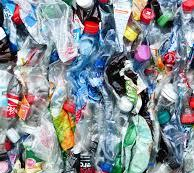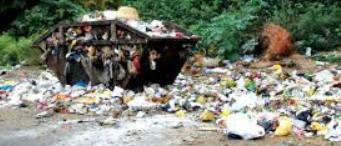 This is in continuation to the previous 3 parts, and as mentioned earlier, has nothing to do with my political affiliations and preferences. Also, I have no economic interests in the subject of concern as of now and not likely to have any in the near foreseeable future. Therefore the thoughts below are as unbiased as they can be. Of course, the only bias that is by default is my personal opinions about the Plastic menace.
This is in continuation to the previous 3 parts, and as mentioned earlier, has nothing to do with my political affiliations and preferences. Also, I have no economic interests in the subject of concern as of now and not likely to have any in the near foreseeable future. Therefore the thoughts below are as unbiased as they can be. Of course, the only bias that is by default is my personal opinions about the Plastic menace.
As mentioned in the earlier part, more garbage bins, maintenance of cleanliness around the bins, effective and timely collection of garbage is critical. However there are 2 complexities to this. One, how can we make it efficient? And two, what do we do with this co-mingled waste along with that which comes wrapped up / packed in plastic carry bags.
For the efficiency part, easily available and inexpensive technologies can help. All the bins can be enabled with a sensor and using IOT technology, the bins can send signals based on the volume of its deposits to a central system which then automatically decides a route map for the garbage vehicle. The garbage vehicle GPS system shall show the realtime map to the driver and the bins can be cleaned up before they overflow. This technology is NOT very expensive unlike the impression it gives. (There are expensive ready solutions from some foreign companies. However, the basic technology is quite cheap and the solution can be built by local software companies at a much cheaper cost.) It can certainly be a part of the civic authority’s annual expense budget. Given that governments balk at expenditure, there are other methods also. It can be made as a mandatory part of a company’s CSR activity to adopt a dozen of dust bins each and maintain them through their CSR budgets.
Once the garbage is collected, the next part is also intensive. Currently whatever piecemeal garbage collection happens, is simply dumped in open dumping grounds. This causes problems such as garbage fires (accidental or otherwise), release of fermentation gases, foul smells, and infections. This needs to be changed immediately.
A good solution is a waste-to-energy plant. Japan has many such plants. In fact, about 8-10% of their total energy comes from WTE plants (Percentage to be confirmed). Many other countries, especially Scandinavian countries have such WTE setups. This is a proven technology and there could be possibilities that corporate houses may want to have a slice of this infrastructural business. Such plants are also set up in Varanasi and Delhi as of the news a few days back. These plants essentially work on incineration basis and given the advancement of technology, extremely effective emission control measures are available. In fact many WTE plant makers integrate highly sophisticated emission control system along with their plant. The residue of this plant when co-mingled waste is used consists of ash, glass and metals. The metals and the glass can be recycled and refined in a foundry while the ash can be used in making fly ash bricks or can be used directly as an additive in concrete for road building. WTE plants of all sizes are available and depending on the waste generation of a city, the plant size can be determined.
However, given that WTE plants are expensive and may not be viable in smaller towns, there is also a possibility of some alternative technologies such as refuse derived fuel. The way it works is, the comingled waste is collected in a central location where at stage 1, the waste is segregated into biodegradable and non biodegradable by waste workers. It is a combination of a mechanical and manual process. Biodegradable waste is converted into biogas which is further used to fire a turbine. Inerts such as glass and metals are manually or mechanically picked up in stage 2 and sold to the relevant buyers who then recycle the same. Other stuff like plastics is again manually classified into recyclable and non recyclable. The non recyclable plastics can be converted into fuel which can also be used to fire the turbines. The recyclables can be recycled to create new plastic. A absolute zero waste circular economy is possible.
For even smaller towns and villages, they can have only local collections and segregation centres. All non degradable material can be stored and periodically transported to larger centres for stage 2 and stage 3 activities. This is the standard honeycomb model where many smaller villages and towns converge into a fewer larger centres which further converge into even few super large centres. Just like we have a standard logistics process from a few manufacturers to the end user, we need to establish this reverse logistics process with significant intervention from the civic authorities, CSR initiatives from corporate houses and local citizen participation.
Palava City in Dombivli has a nice model. They collect garbage from all flats, get it to a single facility where there are many waste workers working for segregation. The waste workers take away the recyclables and sell it to the next point in the recycling supply chain. All degradable material is converted into biogas and fertilizer. They give away the fertilizer to local farmers for free. Other stuff like e-waste is handed over to registered e-waste recyclers. The whole eco system works beautifully.
We have tried a similar model on a small scale for electronic waste with some of our customers and it works very well. The principle is simple. Everyone in the supply chain gets a sizeable incentive to ensure that the system keeps working.
This will ensure that the waste plastics are eliminated from the earth and converted into usable fuel. Additional demand on paper and textiles that would get induced due to plastic ban will get eliminated and in turn remove the indirect disadvantages that I have pointed out in part 1 and 2. The extra fuel generated will reduce the strain on fossil fuels. The residues will assist in reducing sand mining by helping in road building as an alternative additive. The whole waste management activity can come under a regulated industry and provide dignified livelihoods to many.
I leave it to the readers to decide whether to go for the shortcut of a seemingly benign solution that is more of a knee jerk reaction rather than intensely planned policy or whether to oppose it and insist to the state that it should conduct a deeper study on these lines and come out with a more effective, efficient, economically viable, environmentally sustainable and socially beneficial policy.
– The author is an alumnus of IIM Bangalore with specialization in public policy. He works in the waste management space through his venture – ResposeIndia – a company dedicated to manufacturing machinery for e-waste recycling. Earlier to that, he has a long experience in information technology.

